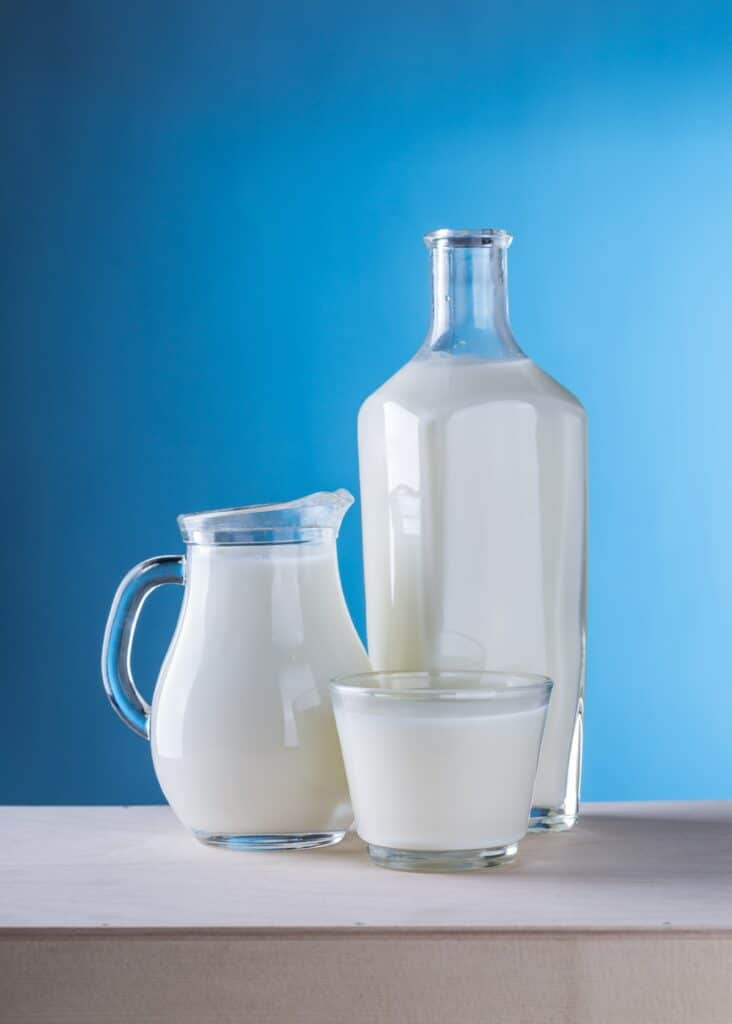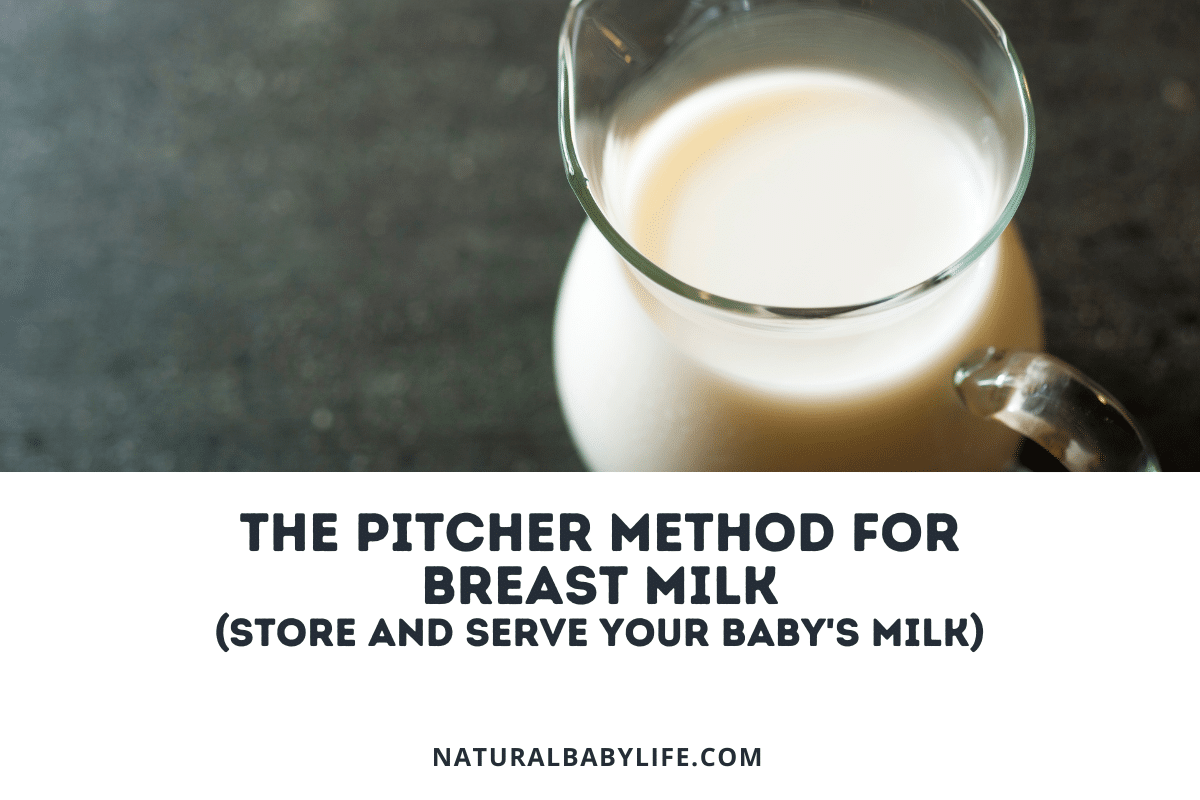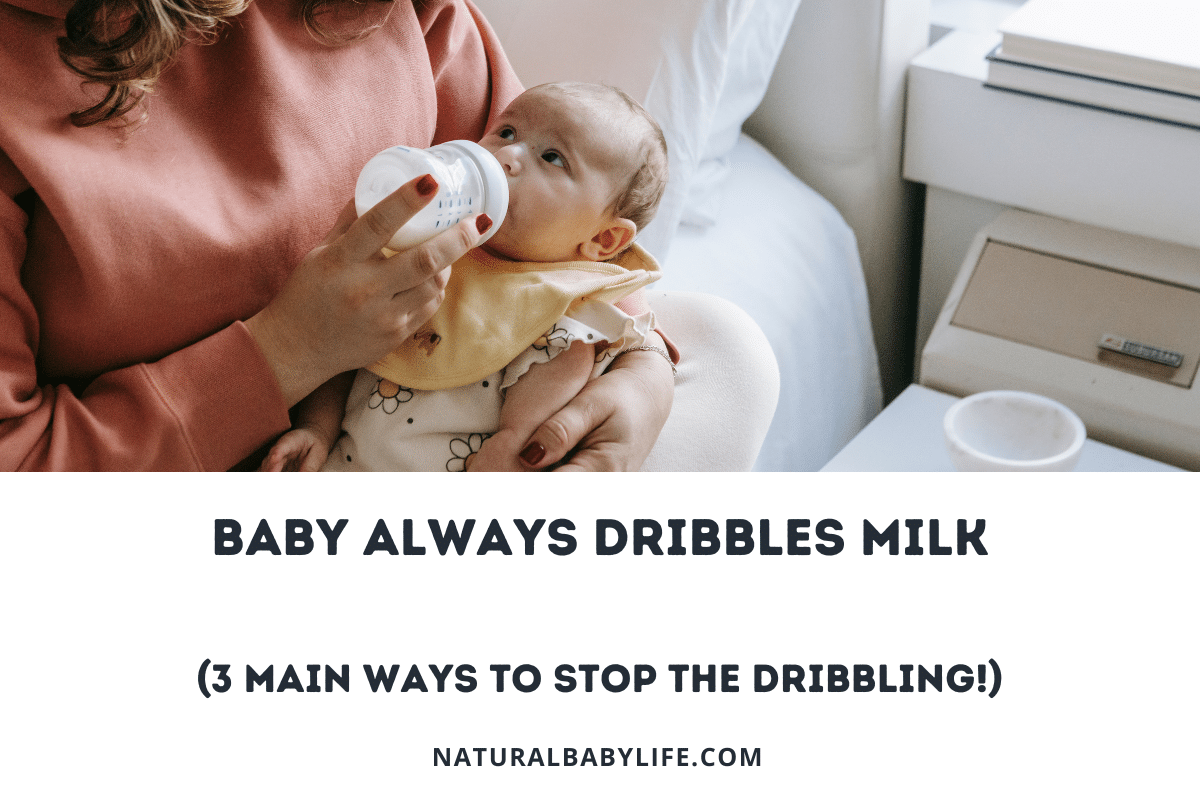Pitchers have long been a time saver for formula-feeding parents, but did you know there is a pitcher method for breast milk? Anything that saves time and effort when you have a new baby is a major parenting win. The pitcher method might be a good option to make your days a little easier.
The pitcher method is a popular way of storing breast milk that involves collecting all the milk produced in a day and storing it in a large container. It eliminates the need to store several bottles or pouches and reduces the waste created by disposable breast milk storage bags.
Read on to learn all you need to decide whether the pitcher method for breast milk is a good choice for your family! For mothers who pump frequently, the pitcher method can be a convenient way of managing their milk supply.

Table of Contents
What Is the Pitcher Method for Storing Breast Milk?
The pitcher method is a breast milk storage technique that involves collecting all the pumped milk for one day and storing it in a large container, such as a pitcher. This method is a great option for mothers who pump frequently and want to simplify their milk storage process.
With the pitcher method, mothers can collect all the milk they pump throughout the day and store it in a single container. At the end of the day or when the container is full, they can prepare the next day’s feeding bottles using the milk collected in the pitcher.
This method can save time, space, and resources, as it eliminates the need for multiple bottles and reduces the amount of washing required.
How to keep the pitcher method for breast milk safe
It is important to note that the pitcher method should only be used for breast milk that has been collected using the same pump and on the same day. Mixing milk from different days or pumps can increase the risk of contamination and spoilage.
Additionally, mothers should follow breast milk storage recommendations to ensure that the milk remains safe and nutritious for their babies.
It is important to label the milk with the date and time it was collected to ensure that the oldest milk is used first. Additionally, mothers should always wash their hands before handling breast milk and use clean bottles and storage containers to reduce the risk of contamination.
Pros of using the pitcher method for breast milk
The Pitcher Method for storing breast milk has several advantages that make it a popular choice for many mothers. Here are some of the pros of using this method:
- Efficient use of space: One of the biggest advantages of using the Pitcher Method is that it takes up less space in the refrigerator. Since you are pouring breast milk into a pitcher or jar throughout the day, bottles aren’t accumulating in your fridge, leaving you more free space. This can be really great if you don’t have a large supply of breast milk bottles.
- Easy to use: The Pitcher Method can simplify feeding and breast milk storage and make it more systematic – no wondering when each bottle expires or finding a 10-day-old bottle in the back of the fridge. Using a pitcher rather than bottles can take up less space in your refrigerator.
- Cost-effective: Using the Pitcher Method can be more cost-effective than using individual breast milk storage bags or bottles. You can use a single pitcher to store all of your milk, which can save you money in the long run.
- Time-saving: The Pitcher Method allows you to cut down on the number of bottles to clean and help prepare future bottles more efficiently. You can simply pour the milk from the pitcher into a bottle when you’re ready to use it. This can be especially helpful if you’re a busy mom who doesn’t have a lot of time to spend on bottle preparation.
Cons of using the pitcher method for breast milk
The pitcher method for storing breast milk is a popular technique that involves collecting breast milk from multiple pumping sessions throughout the day into a single container. While this method has its benefits, there are also some drawbacks to consider before deciding whether or not to use it.
One major disadvantage of the pitcher method is the risk of losing all of the milk if the container is accidentally dropped or broken. Since all of the milk is stored in a single container, a mishap like this can be devastating for a mother who has worked hard to collect and store her breast milk.
Another challenge with the pitcher method is the process of sterilizing the container. Depending on the size of the container and whether or not the mother has a dishwasher, this can be a time-consuming and difficult task.
Additionally, the pitcher method can make it difficult to keep track of the age of breast milk. Since all of the milk is mixed together, it can be hard to remember when each portion was pumped and when it will expire. This can lead to confusion and waste if milk is accidentally left in the container for too long.
Loss of time-sensitive hormones when using the pitcher method
Many of the downsides of the pitcher method for breast milk can be mitigated through labeling, good cleaning, and careful handling. One thing that can’t be fixed is the loss of time-sensitive hormones when breast milk throughout a whole day is combined.
The content of breast milk changes throughout the day. For example, cortisol, which stimulates alertness, is present in human milk three times more than in milk made at night.
Night milk has nutrients to promote better sleep.
Scientists think breast milk helps infants develop a circadian rhythm, but mistiming milk could send their bodies mixed messages.
By combining a whole day’s worth of breast milk in a pitcher, your baby will be getting the day and night milk at all times.

Safe breast milk storage guidelines
It’s important to store breast milk properly to ensure that it stays fresh and safe for your baby to drink. Here are some general guidelines for storing breast milk:
| Storage Location | Temperature | Duration |
|---|---|---|
| Room Temperature | Up to 77°F (25°C) | Up to 4 hours |
| Refrigerator | 32-39°F (0-4°C) | Up to 4 days |
| Freezer | 0°F (-18°C) or lower | 6 (optimal) or up to 1 year (acceptable) |
Remember to always label your breast milk containers with the date and time when the milk was expressed. This will help you keep track of when the milk needs to be used or discarded.
Other breast milk storage rules include:
- Never refreeze human milk after it has been thawed
- Use any leftovers in a bottle within 2 hours of when the baby finished feeding
- Use caution when reheating human milk to avoid scalding your baby
What Type of Pitcher Is Best to Use for Storing Breast Milk?
When it comes to storing breast milk using the pitcher method, it’s important to choose the right type of pitcher. The best pitchers for storing breast milk are those that are made of glass or BPA-free plastic, have a tight-fitting lid, and are easy to clean. Here are some of the top options:
- Dr. Brown’s Formula Mixing Pitcher: This pitcher is one of the most popular choices for storing breast milk. It holds 32oz, and you have the ability to mix the milk using the blade.
- Rubbermaid MixerMate: The MixerMate holds 32oz of breast milk and has a secure top with a spout for pouring.
- Milk Carton Water Bottles: These cute acrylic containers look like old-fashioned milk cartons.
It’s important to note that not all pitchers are created equal when it comes to storing breast milk. Pitchers made of materials that contain BPA or other harmful chemicals should be avoided.
Additionally, pitchers with loose-fitting lids or those that are difficult to clean can increase the risk of contamination.
Tips for Storing Breast Milk in a Pitcher
Storing breast milk in a pitcher can be a convenient and efficient way to save time and space when pumping. Here are some tips to help ensure that your milk stays fresh and safe for your baby:
- Use a food-grade glass or plastic container that has been sterilized before use.
- Label the container with the date and time of the first pumped milk.
- As you add milk throughout the day, mix it with a silicone spatula to incorporate the fat fully.
- Cool newly pumped breast milk before adding it to the pitcher to avoid mixing cold and warm milk together.
- If you have milk that is more than a day old in your pitcher, tag your container with the date of the oldest milk.

FAQs
Here are some frequently asked questions about the pitcher method for storing breast milk:
Why should I use the pitcher method for breast milk?
The pitcher method can save you time and space in your fridge and make it easier to prepare bottles for your baby. By collecting all your pumped milk for one day and storing it in a large container, you can save time and avoid having to wash multiple bottles.
Additionally, the pitcher method can help ensure that your baby is getting a consistent mix of milk, as all the milk in the pitcher will be the same temperature and date as the oldest milk in the pitcher.
Is the pitcher method safe for breast milk?
The pitcher method is safe for storing breast milk as long as proper storage guidelines are followed.
Breast milk storage recommendations suggest that milk can be stored at room temperature for up to 4 hours, in the refrigerator for up to 4 days, and in the freezer for up to 6 months.
It’s important to note that milk should be stored in a clean, closed container and that breast milk that has been thawed should be used within 24 hours.
Is a glass or plastic pitcher better for storing breast milk?
Both glass and plastic pitchers can be used for storing breast milk. However, glass pitchers may be a better option as they are less likely to scratch or absorb odors and can be sterilized more easily than plastic pitchers.
Of course, glass pitchers are heavier and are more likely to break if dropped.
When choosing a pitcher, it’s important to make sure that it has a tight-fitting lid to prevent contamination and that it is made of food-grade materials.











